What Is The Best Lead Scoring Model?
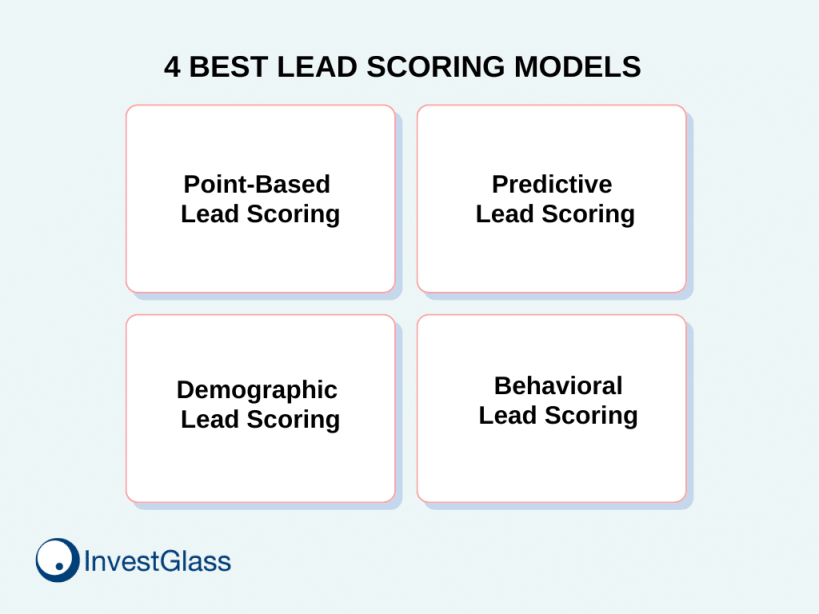
In today’s competitive business landscape, optimizing marketing and sales efforts is paramount. While generating leads is essential, not all leads are equally valuable. This is where lead scoring becomes crucial. A robust lead scoring system, featuring customizable criteria, enables sales and marketing teams to prioritize high-potential leads, thereby maximizing conversion rates. Notably, companies implementing lead scoring experience a 77% increase in lead generation ROI.
A robust lead scoring system, with customizable lead scoring criteria, helps sales and marketing teams prioritize their efforts, focusing on the most promising leads and maximizing conversion rates.
This article delves into the world of lead scoring, exploring its importance, outlining the key steps in the lead scoring process, and showcasing the four best lead scoring models in 2025.
Introduction to Lead Scoring
Lead scoring is a powerful tool used by sales and marketing teams to evaluate the potential of a lead to convert into a customer. It involves assigning numerical values, or scores, to leads based on various criteria such as demographic information, engagement levels, and behavioral data. The goal of lead scoring is to prioritize leads that are most likely to convert into customers, enhancing overall sales and marketing efficiency.
In today’s competitive business environment, not all leads are created equal. Some leads are more likely to become paying customers than others, and identifying these high-potential leads can significantly impact your bottom line. By implementing a robust lead scoring system, sales and marketing teams can focus their efforts on the most promising prospects, ensuring that their time and resources are used effectively.
Definition of Lead Scoring
Lead scoring is a process of ranking leads based on different attributes and data points to assess their readiness to buy. It helps evaluate lead qualities for your business and increase conversion rates. A lead scoring system (or model) enables you to assign point values to prospective buyers. Once they accumulate a set number of points, they become qualified leads.
This system involves evaluating leads based on various criteria, such as their job title, company size, engagement with your content, and their behavior on your website. By assigning point values to these attributes, you can create a comprehensive profile of each lead and determine their likelihood of converting into a customer. This allows your sales team to prioritize their efforts and focus on leads that are most likely to result in a sale.
Importance of Lead Scoring in Sales and Marketing
Lead scoring is essential in sales and marketing as it helps to identify where the leads are in the sales process. It determines whether the lead should continue to be nurtured (MQL) or handed over to the sales (SQL). The lead scoring methodology is especially important for longer sales cycles and high price-tag services. Lead scoring helps save time, lower lead generation costs, and improve alignment between marketing and sales.
By accurately assessing a lead’s readiness to buy, lead scoring ensures that marketing teams can focus on generating high-quality leads, while sales teams can concentrate on nurturing and converting these leads. This alignment between marketing and sales efforts is crucial for optimizing the sales process and achieving better results. Additionally, lead scoring helps in identifying leads that require further nurturing, ensuring that no potential customer is overlooked.
Effective lead scoring offers numerous benefits:
- Improved Lead Conversion: By prioritizing leads based on their potential, sales teams can tailor their approach and increase the chances of converting promising leads into paying customers.
- Increased Sales Efficiency: Instead of wasting time on unqualified leads, sales reps can focus their efforts on those most likely to close, optimizing their time and resources.
- Enhanced Sales and Marketing Alignment: Lead scoring facilitates better communication and collaboration between sales and marketing teams. Marketing teams can focus on generating high-quality leads, while sales teams can effectively nurture and convert them.
- Optimized Marketing ROI: By focusing on the most promising leads, marketing teams can optimize their campaigns and maximize their return on investment.
- Shorter Sales Cycles: By quickly identifying and engaging with qualified leads, sales teams can shorten the sales cycle and close deals faster.
- Data-Driven Decision Making: Lead scoring provides valuable data points that can be used to analyze customer behavior, refine marketing strategies, and improve overall lead management.
- Evaluating Financial Impact: Lead scoring efforts help in evaluating the financial impact of leads identified, emphasizing the need for key performance indicators (KPIs) to measure effectiveness. Creating clear lead scoring models facilitates understanding among both sales and marketing teams, enhancing collaboration and synergy in the sales process.
The Lead Scoring Process: A Step-by-Step Guide
Implementing an effective lead scoring model requires a well-defined process. Here’s a breakdown of the key steps:
- Define Your Ideal Customer Profile (ICP): Before you can score leads, you need to understand who your ideal customer is. Analyze your existing customer data, including demographics, company size, job title, industry, and their pain points. This will help you identify the key characteristics of your best customers.
- Identify Key Scoring Criteria: Based on your ICP, determine the data points that indicate a lead’s likelihood to convert. These can include:
- Demographic Data: Company size, industry, location, job title.
- Behavioral Data: Website visits, content downloads, email engagement, event attendance.
- Engagement Data: Social media interactions, forum participation.
- Intent Data: Researching specific keywords, downloading white papers related to your industry.
- Lead Matches: How well the lead’s information matches your ideal customer profile.
- Assign Point Values: Assign them to each scoring criterion based on its importance. For instance, a lead who has downloaded a case study might receive more points than a lead who has simply visited your website. Consider negative scoring for actions that indicate a lack of interest.
- Set Scoring Thresholds: Determine the minimum score required for a lead to be considered qualified. This threshold will vary depending on your business and sales process.
- Implement a Lead Scoring System: Choose a lead scoring tool or software that integrates with your CRM and marketing automation platform. These lead scoring tools will automate the lead scoring process and provide valuable insights into your leads.
- Test and Refine: Continuously monitor and analyze the performance of your lead scoring model. Adjust point values and scoring criteria as needed to optimize its effectiveness.
- Integrate with Sales Process: Ensure your sales team understands the lead scoring system and uses it to prioritize their efforts. Provide them with the necessary training and resources to effectively utilize the data.
The Best Lead Scoring Models
There are various lead scoring models in use, some of the common ones include demographic, behavioral, predictive, and point-based. Each model has its own lead scoring formula, which adds or subtracts point values based on the criteria set by the sales and marketing teams. Negative scoring, for instance, is a process where points are subtracted if a lead performs an action indicating they may not be a good fit, thus giving them a negative score. On the flip side, positive actions result in a higher lead score. As a result, the marketing and sales teams have to consider all factors to create an effective lead scoring strategy.
For example, in a demographic lead scoring model, the marketing team could assign numerical values based on a lead’s job title, company size, or industry. A behavioral model, on the other hand, scores leads based on actions like email opens, website visits, or downloading a white paper.
4 types of lead scoring models:
- Point-Based Lead Scoring: This is the most traditional and widely used lead scoring model. It involves assigning points to different lead attributes based on their relevance to your ideal customer profile. Demographic data, behavioral data, and engagement data are all considered. For example, a marketing qualified lead (MQL) might receive points for downloading a white paper, visiting a pricing page, or requesting a demo. The sum of these points determines the lead’s overall score.
- Pros: Simple to understand and implement, provides a clear view of lead quality.
- Cons: Can be subjective, requires manual adjustments, may not capture the nuances of lead behavior.
- Predictive Lead Scoring: This model leverages machine learning and historical data to predict a lead’s likelihood to convert. It analyzes past customer data to identify patterns and correlations between lead attributes and conversion rates. This allows for more accurate and data-driven lead scoring. Predictive scoring can often identify promising leads that traditional models might miss.
- Pros: Highly accurate, data-driven, identifies hidden patterns, automates the scoring process.
- Cons: Requires a significant amount of historical data, can be complex to set up, requires expertise in machine learning.
- Demographic Lead Scoring: This model focuses primarily on demographic data, such as company size, industry, job title, and location. It’s particularly useful for B2B companies that target specific types of organizations. For example, a company selling enterprise software might assign higher points to leads from large corporations.
- Pros: Simple to implement, effective for targeting specific industries or company sizes.
- Cons: Can be too simplistic, may overlook other important factors, less effective for B2C companies.
- Behavioral Lead Scoring: This model tracks a lead’s behavior across various touchpoints, such as website visits, email opens, content downloads, and social media interactions. It assigns points based on the lead’s engagement with your content and their demonstrated interest in your products or services. For example, a lead who has visited your pricing page and downloaded a case study would receive a higher score than a lead who has only visited your homepage.
- Pros: Captures lead intent, provides insights into lead engagement, highly effective for nurturing leads.
- Cons: Requires tracking and analyzing large amounts of behavioral data, can be complex to implement.
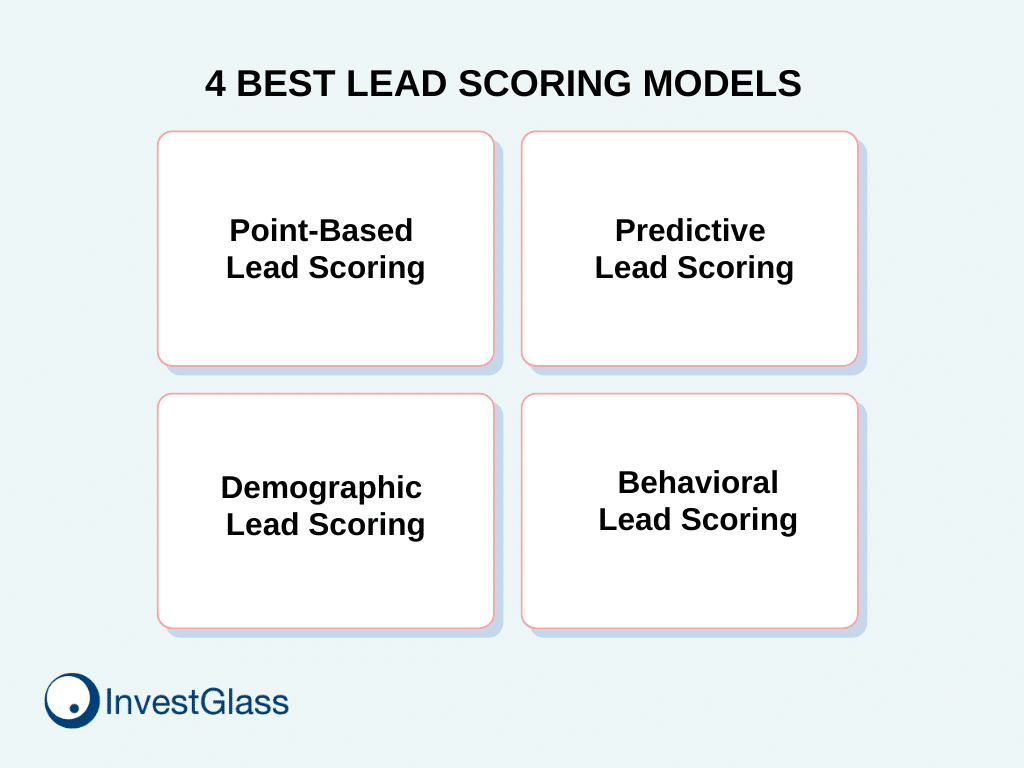
Choosing the Right Lead Scoring Model
The best lead scoring model for your business will depend on several factors, including your industry, target audience, sales process, and available data. Consider the following:
- Data Availability: Do you have enough historical data to implement a predictive lead scoring model?
- Sales Complexity: Are you selling a complex product or service that requires a longer sales cycle?
- Marketing Automation: Do you have a marketing automation platform that can track lead behavior and automate the scoring process?
- Resources: Do you have the necessary expertise to implement and manage a complex lead scoring system?
In many cases, a combination of different models can be the most effective approach. For example, you might combine demographic scoring with behavioral scoring to create a more comprehensive view of each lead.
Lead Scoring Software and Tools
Numerous lead scoring software and tools are available on the market. When choosing a tool, consider the following features:
Ease of Use: The tool should be easy to use and understand for both marketing and sales teams.
Integration with CRM and Marketing Automation: Ensure the tool integrates seamlessly with your existing systems.
Customizable Scoring Rules: The ability to define your own scoring criteria and point values.
Automated Scoring: The tool should automatically score leads based on predefined rules.
Reporting and Analytics: Access to reports and analytics to track the performance of your lead scoring model.
Evaluating a Lead Scoring Model and lead scoring process
Evaluating a lead scoring model involves assessing its effectiveness in identifying high-quality leads. Businesses can develop their own model by integrating data from both implicit and explicit sources, aligning it with their specific needs and target audience. The key is to ensure the model accurately qualifying leads to distinguish between hot and cold leads, enabling sales teams to focus on prospects with the highest conversion potential.
If a model generates too many or too few marketing-qualified leads, it may require fine-tuning. Likewise, if high-scoring leads fail to convert while lower-scoring ones frequently become customers, adjustments are needed to improve accuracy.
Another important indicator is the length of the sales cycle. A well-functioning lead scoring model should help shorten it. However, if deals take too long to close or frequently fall through, it may be time to refine your approach.
Key Takeaways Lead Scoring
- Regularly review and refine your lead scoring model. Customer behavior and market dynamics change, so your lead scoring model should adapt accordingly.
- Align your lead scoring system with your sales process. Ensure that your sales team understands the lead scoring system and uses it to prioritize their efforts.
- Use lead scoring data to inform your marketing strategies. Identify which marketing activities are generating the most qualified leads and optimize your campaigns accordingly.
- Don’t rely solely on lead scores. Lead scoring is a valuable tool, but it shouldn’t be the only factor in determining lead quality. Sales reps should still use their judgment and experience to assess each lead.
What is Lead Management?
- Demographic Scoring: This model is about scoring leads based on demographic data such as job title, company size, location, and industry. Assigning point values to these factors helps you focus on leads that fit your target audience.
- Behavioral Scoring: Behavioral scoring assigns points based on a lead’s behavior or engagement with your company. This could include website visits, social media engagement, email interaction, and content downloads.
- Predictive Scoring: Predictive lead scoring uses machine learning to analyze a vast number of data points from past customer behaviors and trends. It predicts which leads are most likely to convert, enabling marketing and sales teams to focus their efforts on these high-potential leads.
- Collaborative Scoring: This model combines demographic and behavioral data with insights from your sales team, leading to a more rounded scoring model. It allows your sales and marketing teams to work collaboratively in scoring leads.
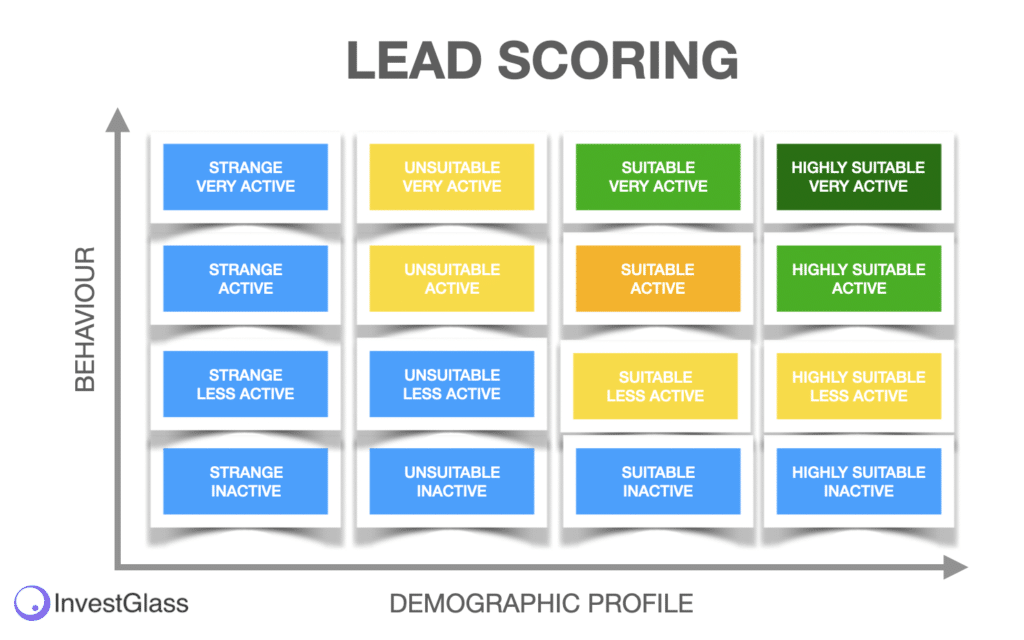
How Does It Work in InvestGlass Swiss CRM?
InvestGlass is a powerful tool that offers game-changing for sales process benefits to your lead scoring models. It integrates sales and marketing data in one place, allowing you to craft a more comprehensive and accurate lead scoring model. Whether you’re using demographic, behavioral, or predictive models, InvestGlass’s expansive data analytics capabilities ensure that you’re drawing from the most relevant and up-to-date data.
Unlike traditional lead scoring, InvestGlass is using artificial intelligence in predictive lead scoring. By utilizing machine learning algorithms, it can analyze customer data, learn from patterns, and predict future outcomes. This helps you identify high-potential leads with greater precision, enabling your sales team to focus on leads with the highest probability of conversion.
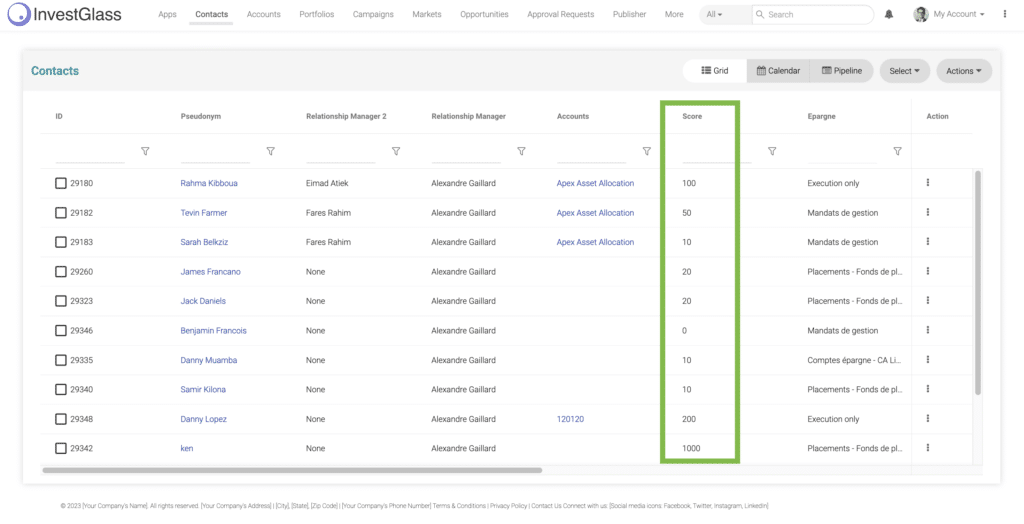
Moreover, InvestGlass offers a marketing automation solution that enhances the efficiency of your lead scoring process and gives lead scoring solutions. It can automatically assign scores to leads based on predefined criteria and update these scores in real-time as leads interact with your business. This not only ensures that your lead scores always reflect the most current data, but it also saves your team valuable time and resources.
One of InvestGlass’s most impressive lead scoring features is its ability to apply multiple lead scoring models. This means you can implement different scoring models for different customer personas, product lines, or business units to optimize lead scoring and further refine your lead scoring strategy. Our team is happy to help you find a lead scoring methodology to match your expectations. The Swiss sovereign CRM is flexible and is adapted to any business model.
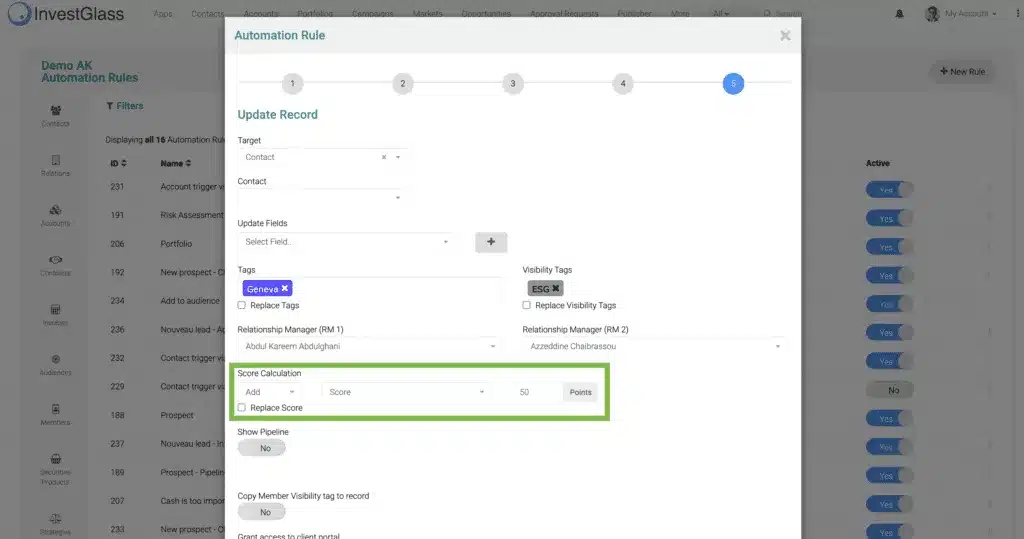
Furthermore, InvestGlass supports a collaborative approach to lead scoring. It allows your sales and marketing teams to work together in the lead scoring process, providing a more holistic view of each lead. This can lead to better understanding, improved accuracy, and ultimately, more successful conversions.
Conclusion
Lead scoring is an essential practice for any business looking to optimize its sales and marketing efforts. By implementing an effective lead scoring model, you can prioritize your resources, improve lead conversion rates, and accelerate your sales cycle. Whether you choose a point-based system, a predictive model, or a combination of approaches, the key is to continuously analyze, refine, and adapt your model to ensure it aligns with your evolving business needs and helps you focus on generating leads and converting the potential leads. By focusing on those leads, you can maximize your ROI, improve sales and marketing alignment, and drive business growth.